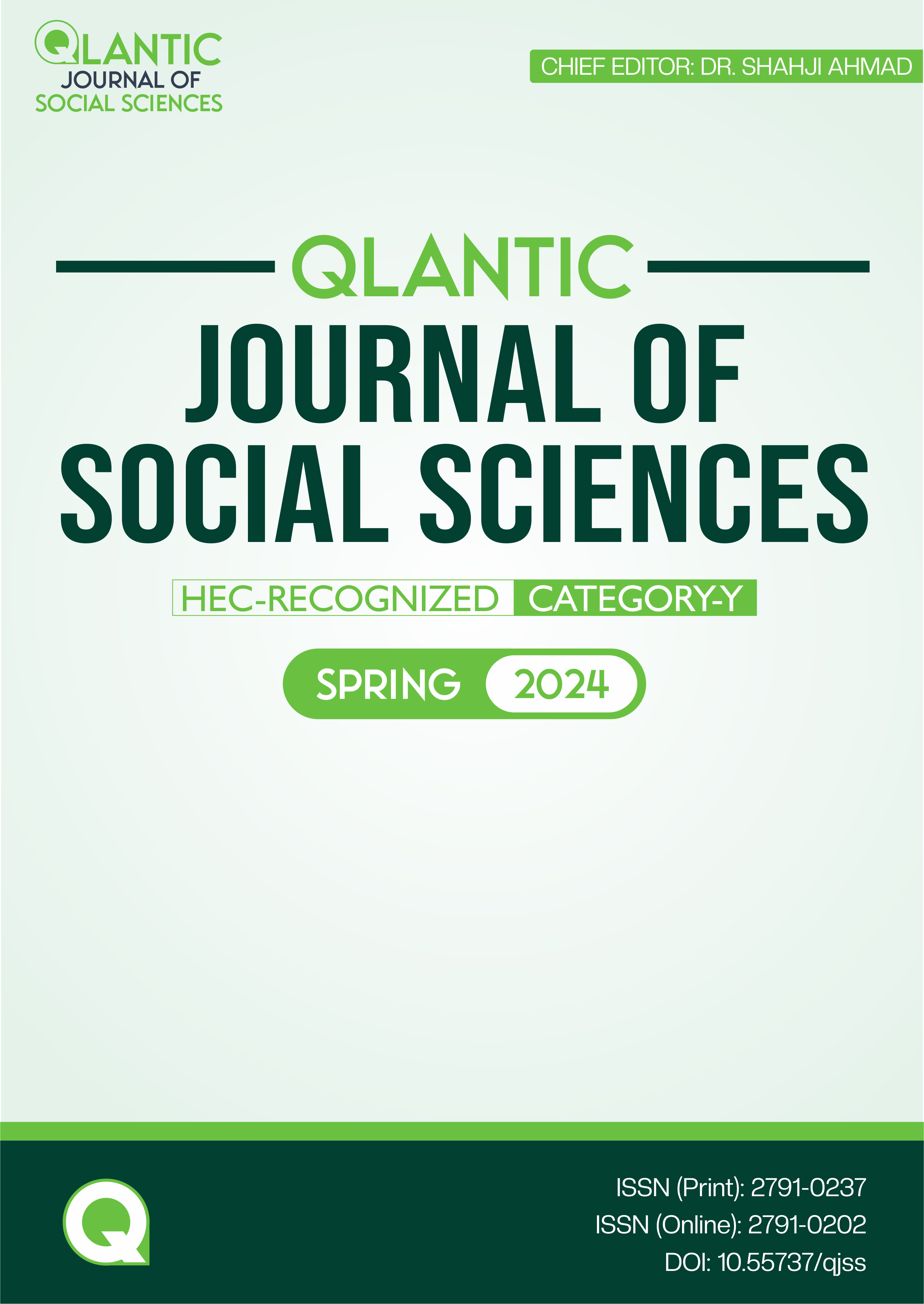The Influence of Fashion bloggers on Consumer Behavior: Exploring Credibility, Engagement, and Homophily among consumers in Lahore, Pakistan
DOI:
https://doi.org/10.55737/qjss.901567405Keywords:
Fashion Influencers, Consumer Behavior, Engagement, Brand Preferences, PakistanAbstract
The fashion industry is a vibrant and globalized sector with a rich tapestry of style and culture. In recent years, the rise of fashion influencers has significantly impacted consumer behaviour. This study investigates the sway fashion bloggers hold over consumers’ purchasing intentions, examining the dimensions of credibility, engagement, and homophily, with research objectives containing probing brand preferences, gauging the influence of bloggers’ appearance, analyzing purchasing decisions based on recommendations, and scrutinizing the positive impact of homophily on consumer behaviour. By employing a survey research technique, this study collected responses from 700 respondents, comprising 411 females and 289 males, primarily sourced from Lahore, Pakistan. The data analysis involves correlation tests to explore the relationships between fashion bloggers' credibility, engagement, homophily, and consumers' buying intentions. The findings reveal significant correlations between these variables, indicating that fashion bloggers play a crucial role in influencing consumer behaviour. The study contributes to the understanding of the role of fashion bloggers in the contemporary marketing landscape and highlights the importance of considering bloggers' credibility, engagement, and homophily in marketing strategies. These findings stress the need for fashion brands to cultivate genuine connections with consumers through influencer collaboration, enabling them to develop more effective marketing strategies and strengthen brand loyalty in the digital landscape.
Downloads
References
Adel, N. (2023). Fashion bloggers vs. young women: an overlapped relationship controlled by electronic word of mouth. The Arab Journal of Media and Communication Research (AJMCR), 2023(40), 2-19. https://doi.org/10.21608/jkom.2023.304793
Ahmad, W., Jafar, R. M. S., Khan, N. R., Hameed, I., & Fatima, N. (2023). Does green blogging affect consumer green behaviour? The moderating role of Green Psychology variable. In Emerald Publishing Limited eBooks (pp. 183–192). https://doi.org/10.1108/978-1-80455-678-820231010
Alhalwachi, F. (2021). Narratives of infertile Muslim women: the construction of personal and socio-cultural identities in weblogs (Doctoral dissertation, Birkbeck, University of London). http://dx.doi.org/10.13140/RG.2.2.33107.60961
Ao, L., Bansal, R., Pruthi, N., & Khaskheli, M. B. (2023). Impact of social media influencers on customer engagement and purchase Intention: A Meta-Analysis. Sustainability, 15(3), 2744. https://doi.org/10.3390/su15032744
Assis, E. E., Ferreira, V. M. R., & Andrade, F. O. (2020). Blogs como ferramentas de marketing e sua influência na decisão de compra de produtos de moda e beleza. REMark - Revista Brasileira De Marketing, 19(3). https://doi.org/10.5585/remark.v19i3.17763
Bai, S., Yin, Y., Yu, Y., Wei, S., & Wu, R. (2021). Effects of Self-Expressive Brand and Susceptibility to interpersonal influence on brand addiction: Mediating role of brand passion. Frontiers in Psychology, 12. https://doi.org/10.3389/fpsyg.2021.602023
Cheng, R. (2015). BLOG INTENTION BASED ON FASHION INVOLVEMENT AND TRUST. International Journal of Electronic Commerce Studies, 6(1), 19–36. https://doi.org/10.7903/ijecs.1390
Cho, S., Park, C., & Lee, F. (2020). Homophily and peer-consumer behaviour in a peer-to-peer accommodation sharing economy platform. Behaviour & Information Technology, 41(2), 276–291. https://doi.org/10.1080/0144929x.2020.1803403
Derashri, I., & Gogia, S. K. (2019). Influence of fashion bloggerss on consumer buying behavior: a literature review. The IIS University Journal of Commerce & Management, 8(1), 9-18. https://iisjcm.org/sites/default/files/IISJCM/2019/2.%20Isha%20Derashri%20&%20Sarabjeet%20Kaur%20Gogi.pdf
Djafarova, E., & Rushworth, C. (2017). Exploring the credibility of online celebrities’ Instagram profiles in influencing the purchase decisions of young female users. Computers in Human Behavior, 68, 1–7. https://doi.org/10.1016/j.chb.2016.11.009
Foroudi, P., Nazarian, A., & Aziz, U. (2019). The effect of fashion e-Blogs on women’s intention to use. In Advances in theory and practice of emerging markets (pp. 19–40). https://doi.org/10.1007/978-3-030-24374-6_2
Jain, A., & Meyers, S. (2022). Young consumer conformity and identity amplified by social media: marketing applications. Journal of Student Research, 11(3), https://doi.org/10.47611/jsrhs.v11i3.3491
Johnstone, L., & Lindh, C. (2022). Sustainably sustaining (online) fashion consumption: Using influencers to promote sustainable (un)planned behaviour in Europe’s millennials. Journal of Retailing and Consumer Services, 64, 102775. https://doi.org/10.1016/j.jretconser.2021.102775
Keenan, L. (2015). An investigation into the impact of Irish fashion bloggerss on the creation of brand awareness amongst women aged 18-35 (Doctoral dissertation, Dublin Business School). https://esource.dbs.ie/items/0322ccc7-ab83-4e5b-b5b8-2be21eae65d3
Kim, J., Yang, K., Zeng, X., & Cheng, H. P. (2021). The influence of perceived benefit on structural, cognitive and relational social capital in fashion blogs; the study of female users. Journal of Fashion Marketing and Management: An International Journal, 25(2), 310-330. http://dx.doi.org/10.1108/JFMM-06-2019-0125
Koivisto, M. (2019). Credibility in the blogosphere: Fashion bloggers attitudes to blog marketing. https://www.doria.fi/handle/10024/173248
Kou, Y., Gray, C. M., Toombs, A. L., & Adams, R. S. (2018). Understanding social roles in an online community of volatile practice: A study of user experience practitioners on reddit. ACM Transactions on Social Computing, 1(4), 1-22. http://dx.doi.org/10.1145/3283827
Kusumasondjaja, S. (2015). Information quality, homophily, and risk propensity: Consumer responses to online hotel reviews. Journal of Economics, Business & Accountancy Ventura, 18(2), 241-252. https://doi.org/10.14414/jebav.v18i2.451
Lewis, R., & Santos, E. (2018). Operations as a Competitive Advantage in Biotechnology. https://www.mckinsey.com/~/media/McKinsey/Industries/Pharmaceuticals%20and%20Medical%20Products/Our%20Insights/Operations%20as%20a%20competitive%20advantage%20in%20biotechnology/Operations-as-a-competitive-advantage-in-biotechnology.pdf
Luo, N., Guo, X., Lu, B., & Chen, G. (2018). Can non-work-related social media use benefit the company? A study on corporate blogging and affective organizational commitment. Computers in Human Behavior, 81, 84-92. https://psycnet.apa.org/doi/10.1016/j.chb.2017.12.004
Madhura, K., & Niyaz Panakaje, D. (2022). Customer Perception in Relationship Between Social-Media and Purchasing Behavior of Fashion Products. Available at SSRN 4187212. http://dx.doi.org/10.2139/ssrn.4187212
Mainolfi, G., & Vergura, D. T. (2022). The influence of fashion bloggers credibility, engagement and homophily on intentions to buy and e-WOM. Results of a binational study. Journal of Fashion Marketing and Management: An International Journal, 26(3), 473-494. http://dx.doi.org/10.1108/JFMM-03-2020-0050
McCormick, K. (2016). Celebrity endorsements: Influence of a product-endorser match on Millennials attitudes and purchase intentions. Journal of retailing and consumer services, 32, 39-45. http://dx.doi.org/10.1016/j.jretconser.2016.05.012
Mikalef, P., Giannakos, M. N., & Pappas, I. O. (2017). Designing social commerce platforms based on consumers’ intentions. Behaviour & Information Technology, 36(12), 1308-1327. https://doi.org/10.1080/0144929x.2017.1386713
Nash, J. (2019). Exploring how social media platforms influence fashion consumer decisions in the UK retail sector. Journal of Fashion Marketing and Management: An International Journal, 23(1), 82-103. https://doi.org/10.1108/jfmm-01-2018-0012
Neuliep, J. W., & McCroskey, J. C. (1997). The development of intercultural and interethnic communication apprehension scales. Communication Research Reports, 14(2), 145-156. https://doi.org/10.1080/08824099709388656
Raghunathan, R., & Corfman, K. (2006). Is happiness shared doubled and sadness shared halved? Social influence on enjoyment of hedonic experiences. Journal of Marketing Research, 43(3), 386-394. https://doi.org/10.1509/jmkr.43.3.386
Rettberg, J. W. (2014). Blogging. Polity.
Rocamora, A. (2018). The Labour of Fashion Blogging. Fashioning Professionals, 65–82. https://doi.org/10.5040/9781350001879.ch-004
Rupik, K. (2015, November). Customer engagement behaviour in the fashion industry. In International Conference on Marketing and Business Development (Vol. 1, No. 1, pp. 338-346). Bucharest University of Economic Studies Publishing House. https://doi.org/10.1016/j.jclepro.2022.130394
SanMiguel, P., & Sádaba, T. (2017). Nice to be a fashion blogger, hard to be influential: An analysis based on personal characteristics, knowledge criteria, and social factors. Journal of Global Fashion Marketing, 9(1), 40-58. https://doi.org/10.1080/20932685.2017.1399082
Sano, K., & Romão, J. (2022). Exploring how travel blogs influence Chinese tourists to visit Japan: A netnographic study of Chinese tourists travel blogs. Handbook on Tourism and Social Media. https://doi.org/10.4337/9781800371415.00032
Sbaffi, L., & Rowley, J. (2017). Trust and credibility in web-based health information: A review and agenda for future research. Journal of Medical Internet Research, 19(6), e218. https://doi.org/10.2196/jmir.7579
Sedeke, K., & Arora, P. (2013). Top ranking fashion blogs and their role in the current fashion industry. First Monday. https://doi.org/10.5210/fm.v18i8.4314
Segova, A. (2020). Consumer responses to influencer marketing on Instagram (Doctoral dissertation, University of Technology Sydney (Australia)). https://api.core.ac.uk/oai/oai:opus.lib.uts.edu.au:10453/142276
Shahid, R., Riaz, H., & Ahmed, H. (2023). From Likes to Buys: Exploring the Impact of Social Media Influencer Marketing on Consumer Purchase Intentions Through Credibility. International Journal of Trends and Innovations in Business & Social Sciences, 1(3), 87-99. https://doi.org/10.48112/tibss.v1i3.644
Shen, Z. (2021). “The other side of the brocade”: Translating fashion blogs and data mining. TEXTILE, 20(2), 134-150. https://doi.org/10.1080/14759756.2021.1963142
Sokolova, K., & Kefi, H. (2020). Instagram and YouTube bloggers promote it, why should I buy? How credibility and parasocial interaction influence purchase intentions. Journal of Retailing and Consumer Services, 53, 101742. https://doi.org/10.1016/j.jretconser.2019.01.011
Sun, Y., Wang, R., Cao, D., & Lee, R. (2021). Who are social media influencers for luxury fashion consumption of the Chinese Gen Z? Categorisation and empirical examination. Journal of Fashion Marketing and Management: An International Journal, 26(4), 603-621. https://doi.org/10.1108/jfmm-07-2020-0132
Tran, Q. H. (2020). Supply chain management in Vietnamese fashion vlogger attributes vs product consumption: A double conceptual framework. Int. J Sup. Chain. Mgt 9(2), 582. https://doi.org/10.59160/ijscm.v9i2.4663
Vincent Jaiwant, S. (2023). Changing structure of consumer buying behaviour and expectation in the Digital Era. Industry 4.0 and the Digital Transformation of International Business, 207-215. https://doi.org/10.1007/978-981-19-7880-7_12
Williams, J. D., Lee, W., & Henderson, G. R. (n.d.). Diversity issues in consumer psychology. Handbook of Consumer Psychology. https://doi.org/10.4324/9780203809570.ch35
Yang, S., & Kang, M. (2009). Measuring blog engagement: Testing a four-dimensional scale. Public Relations Review, 35(3), 323-324. https://doi.org/10.1016/j.pubrev.2009.05.004
Zak, S., & Hasprova, M. (2020). The role of influencers in the consumer decision-making process. SHS Web of Conferences, 74, 03014. https://doi.org/10.1051/shsconf/20207403014
Zhang, Y., & Caverlee, J. (2019). Instagrammers, Fashionistas, and me. Proceedings of the 28th ACM International Conference on Information and Knowledge Management. https://doi.org/10.1145/3357384.3358042
Downloads
Published
Issue
Section
License
Copyright (c) 2024 Saima Kausar, Mudasar Hussain Shah, Saima Iqbal

This work is licensed under a Creative Commons Attribution-NonCommercial 4.0 International License.



